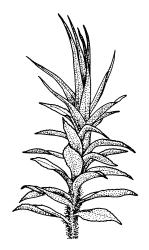Plants medium-sized to robust, erect, in dense or loose tufts, usually on decaying animal matter. Stems often fleshy, in cross-section with a well-developed central strand, thick-walled cortical cells, and large, parenchymatous medullary cells, usually densely beset with smooth or papillose rhizoids. Leaves soft, wide- or erect-spreading when moist, crisped when dry, mostly broad, ovate-lanceolate, elliptic, oblong, or obovate, mostly plane, entire, dentate, or rarely spinose to laciniate at margins, mostly unbordered; upper laminal cells large, smooth, and thin-walled, mostly oblong-hexagonal, not or weakly differentiated at margins, becoming larger and more oblong towards leaf base; alar cells not differentiated. Costa single, strong, ending below the apex to excurrent. Axillary hairs present but often obscured by rhizoids.
Autoicous or dioicous. Perichaetia terminal, with the leaves mostly little differentiated. Perigonia terminal and ± discoid, with filiform or clavate paraphyses. Setae elongate (or rarely very short in non-N.Z. species); capsules erect or nearly so, symmetric, highly variable in shape but usually with an elongate or highly inflated neck (hypophysis) and a smaller urn, stegocarpous (in N.Z. species) or rarely cleistocarpous; stomata present, superficial and 2-celled, often abundant; annulus weakly differentiated or lacking; operculum bluntly conic or convex, rarely absent. Peristome single, either erect or strongly reflexed when dry, the 16 teeth often paired, or rarely unpaired and bifid, variably pigmented and ornamented. Calyptra nearly always mitrate and smooth above. Spores small, smooth or weakly ornamented, sometimes dispersed in clusters.
The Splachnaceae include 6 (Goffinet et al. 2009) or 7 genera and c. 70 species. The family is predominantly distributed in temperate to cold parts of the northern hemisphere, temperate parts of the southern hemisphere, and high elevations in the neotropics. One genus, Tayloria, and 4 species are documented from N.Z.; a fifth species in this genus is endemic to Tasmania.
Members of the Splachnaceae characteristically grow on decaying faeces, animal carcasses or on highly nitrogen-enriched sites (such as bird perches). Quoting Crum & Anderson (1981): "the differentiated ‘neck’ of the capsule is an outstanding characteristic of the family. It reaches its greatest development in the large bladderlike or skirtlike [hypophysis] of [the northern hemisphere genus] Splachnum." This fascinating family is unique among mosses for having specialised symbiotic relationships with insects (dipterans) that facilitate spore dispersal. Approximately half of the species in the family have fly-dispersed spores (Marino et al. 2009). These species have highly modified, often highly coloured sporophytes that produce volatile and sometimes aromatic compounds that attract flies. Their spores are often cohesive and released in irregular clusters. Marino et al. (2009) suggest there is an inverse relationship between size and showiness of the hypophysis and the complexity of their volatile odours. All species of Tayloria in N.Z. have sporophytes producing dung- or carrion-like odours.
| Category | Number |
|---|---|
| Indigenous (Endemic) | 1 |
| Indigenous (Non-endemic) | 3 |
| Total | 4 |




